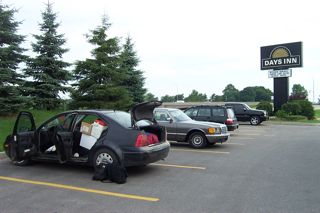Janet’s Agriculture Tour to France was planned for early spring 2009, but has been re-scheduled for 2010; check in with at the Guild web site for more information about dates and updated itineraries.
—
Maine Cheese Guild France Trip Proposal:
February 22 – March 3, 2009
Day 1 – Sunday 22nd Feb – Depart from Logan Airport to catch our overnight flight to Paris. Relax with
In flight meal service and entertainment.
Day 2 – Monday 23rd Feb Arrive Paris, and transfer to hotel in Paris city center “the City of Lights” is truly one of the world’s great cities. Although it has a population of over 10 million, the historic core of the city is largely untouched by modern development. Its broad boulevards and wide open spaces create stunning vistas punctuated by world famous landmarks such as the Eiffel Tower and Arc de Triomphe.
This afternoon there will be a guided panoramic sightseeing tour of the city including the Arc de Triomphe, the Champs Elysees, Place de la Concorde and Notre Dame Cathedral. Welcome dinner tonight. O/N PARIS (D)
Day 3 – Tuesday 24th Feb Early departure from hotel this morning to visit Rungis Market in the south of Paris, the largest wholesale market in France. It has a surface area of 320 hectares and employs 15,000 to facilitate the flow of millions of tons of produce, meat, cheese, poultry and even flowers. Rungis is a distribution point of food not only for France but for many European countries. France produces more than 250 different cheeses – the selection is endless. There will be a guided tour of the market followed by breakfast with a chance to sample some the local produce being sold.
Afterwards continue heading south passing through the rural regions of Isle de France and Champagne en route to Burgundy with a visit featuring a number of well known cheese makes including Brie and Coloumiers. Lunch included at a Ferme Auberge.
This afternoon continue south visiting en route a dairy farm producing a number of specialty cheeses of this region – St Florentin and Soumaintrain
Arrive later to this afternoon in Dijon. Famed for its spicy mustard produced here, Dijon is the ancient capital of Burgundy. The region, of course, is renowned for its fabulous wine and cheese. Dijon is the perfect place to enjoy these delicacies along with its many fine buildings and old world charm.
O/N DIJON (BLD)
Day 4 – Wednesday 25th Feb Depart Dijon this morning and continue south traveling through the famous Cote D’Or (Gold Coast) wine producing region on Burgundy. En route make a stop at a vineyard for a tour of the winery and wine-tasting. A lunch stop will be made in the town of Beaune, an important wine producing centre. The town still retains its defensive city walls as well as many other attractive medieval features. This afternoon continue south through Charolles region of Burgundy where there will be a visit to a goat farm which produces goat cheeses such as Le Charolais and L’Alexou. O/N Clermont Ferrand (BD)
Day 5 – Thursday 26th Feb Today there will be a full day program visiting a number of cheese producers in the Auvergne region. Lunch included today.
Visit Laiterie de la Montagne in St Nectaire which produces a number of cheeses typical to this area including St Nectaire, Cantal and Fourme d’Ambert. Visit Gaec de Joli Bois, a farm with Montbeliarde Cattle (known as the cheese maker breed in France) also producing St Nectaire Cheese. O/N Clermont Ferrand (BL)
Day 6 – Friday 27th Feb Depart the Auvergne today and head north towards the Loire Valley. The Loire is France’s longest river stretching east to west for over 600 miles. The mild climate and fertile alluvial soil make this a region well suited for growing fruit, vines and vegetables. In addition the region is home to a unique concentration of chateaux, some of the most extravagant and stunning examples of Renaissance and Baroque architecture to be found in all of Europe. Today we visit La Fromagerie Jacquin, which makes a large range of cheese from both cow and goat’s milk.
This afternoon there will be a visit to the Chateau of Chenonceaux. With its elegant arches spanning the river Cher, Chenonceaux is for many the most visually appealing of all chateaux along the Loire valley.
O/N AMBOISE = (BD)
Day 7 – Saturday 28th Feb Depart the Loire Valley this morning and continue journey north to Normandy, a region of patchwork fields, lush rolling pastures, dairy cattle and apple orchards. Visit Graindorge cheese factory in Livarot maker of some of the best known cheese brands of this region including Camembert, Livarot and Pont L’Eveque. Lunch included today. Arrive in Caen mid-afternoon with the rest of the day free for independent sightseeing and shopping. O/N CAEN (BLD)
Day 8 – Sunday 1st March This morning there will be an opportunity to visit St Pierre Farmer’s Market in Caen with over 400 stalls to browse. Afterwards depart for an excursion to Mont Saint Michel, the great monastery island-fortress that seems to rise out of the sea from the vast Bay of Mont St Michel. This is one of the most famous sights of all France. We tour the little town and visit the medieval Abbey, built atop the rocky hillside.
O/N CAEN (BD)
Day 9 – Monday 2nd March Depart Caen for a visit to a farm growing apples for the production of cider and calvados including an opportunity for tasting.
Continue to Rouen, the city infamous for being where Joan of Arc was burnt on the cross in 1431. Although badly bombed during the war, the city has been carefully restored and is one of the most attractive cities of northern France, featuring a magnificent medieval cathedral.
On arrival there will be free time for lunch and an opportunity for some independent sightseeing and shopping. Depart this afternoon for Paris.
There will be a farewell dinner cruise tonight on the Bateaux Mouches. With most of the major monuments illuminated at night, cruising along the Seine in a glass topped boat is a great way to enjoy Paris in its most romantic setting. FYI – This will be a highlight of the trip, creating memories you will never forget. O/N PARIS (BD)
Day 10 – Tuesday 3rd March Depart for airport to return to Boston
Tour Includes:
Round trip air from Boston to Paris
8 hotel nights based on sharing twin room (3/4*)
8 breakfasts 7 dinners and 3 lunches (As indicated by BLD on the itinerary)
Coach services for duration of tour as specified on itinerary
Guided sightseeing of: Paris, Mont Saint Michel
Entrances to: Chenonceau, Mont Saint Michel
All farm and technical visits
Guided tour of Rungis market (including breakfast)
Wine tasting (Cote d’Or) & Calvados tasting (Normandy)
Services of Stita tour manager
Tips and gratuities for included services
Baggage handling in hotels, 1 piece per person
Not Included:
Transportation to Logan Airport – Suggest Concord Trailways from Portland
Gratuities for driver, escort and local guides
Any other meals not listed in itinerary and any personal expenses.
Prices Per Person:
Double Occupancy $3215.00 = $550.00 Single Supplement
CONDITIONS & RESPONSIBILITY
TO MAKE RESERVATIONS: A deposit of $500.00 per person is due with Reservation Form by July 15. The balance will be due no later than November 17, 2008. We will contact you prior to that date to reconfirm the final payment in the event there is an increase due to a fuel surcharge by the airline.
CANCELLATION POLICY:
We reserve the right to cancel if minimum passengers (25) are not booked, or to assess a surcharge with the group’s approval. If our agency cancels the trip, your deposit is fully refundable. If you cancel after deposit and prior to final payment, $100.00 pp is non refundable. No refund after final payment. Therefore, we strongly urge you to purchase cancellation insurance for your protection. Please check if you want insurance on the reservation form and a form will be forwarded to you.
RESPONSIBILITY:
Dube Carlson Wagonlit Travel is acting only as an agent for the passenger and therefore accepts no responsibility for any delayed departures or arrivals, missed connections, loss or damage, or injury to person or property. Dube Travel and STITA Tours reserve the right to change the itinerary and substitute arrangements of any equal value, if in their opinion circumstances warrant change.
SPACE IS LIMITED – Send your Reservation and Deposit Soon!

